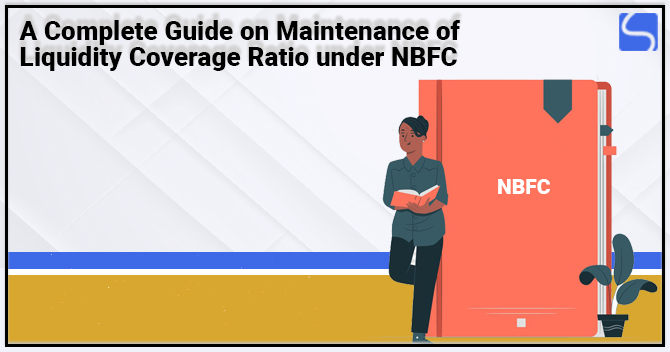A Complete Guide on Maintenance of Liquidity Coverage Ratio under NBFC

Karan Singh | Updated: Mar 31, 2021 | Category: NBFC, RBI Advisory
NBFC or Non-Banking Financial Company is one of the primary contributors to the economy of India. Over the previous years, this financial company has observed outstanding growth owing to its client-oriented business roles. Their operational protocol endures a weird resemblance to the regional banks. Their key area of function is to provide money through short-term and long-term loans with an affordable rate of interest. Earlier, the Reserve Bank of India has instructed the requirements to maintain the liquidity coverage ratio under NBFC. In this blog, we are going to discuss the maintenance of high-quality liquid assets and Liquidity Coverage Ratio under NBFC.
Table of Contents
An Overview of Liquidity Coverage Ratio under NBFC
This ratio states the proportion of the High-Quality Liquidity Assets that a Non-Banking Financial Company has to manage and control to fulfil the net cash outflows over the time period of thirty days or one month in the state of the financial crisis of a market. The Non-Banking Financial Companies function by obtaining credit from traditional lenders such as mutual funds, banks and offering credit to borrowers in the marketplace. This model of NBFC functions flawlessly in a strong economy. But, the problem may experience in the gaze of the financial crisis. At the time of such phase, the ability of a borrower to repay the loans may also be negotiated, which in turn generates the shortage of funds or money and Liquidity Coverage Ratio under NBFC.
The mathematical expression for LCR (Liquidity Coverage Ratio under NBFC) is as follow:
Mathematically, it is given by:
The stock of High-Quality Asset divided (/) by Total Net Cash flows over the next thirty days.
It is essential to main 100% of Liquid Coverage Ratio for SIFI (Important Financial Institutions). According to the aforementioned definition, we can accept that the LCR or Liquid Coverage Ratio is comprised of 2 authoritativecomponents as given below:
- High-Quality Liquid Assets: It denotes the assets which are imaginative and can be transformed into cash effortlessly and instantly at little or no loss to cover the net cash outflows at the time of liquidity stress time of thirty days.
- Total Net Cash Outflows: It states that the difference between total estimated cash outflows and total estimated cash inflows during a liquidity stress period of thirty days.
Also, Read: Operational Manual of the NBFCs: A Complete Guide
Let’s Understand the High-Quality Liquid Assets
According to the Base III Framework associated with Liquidity Standard, High-Quality Assets are categorized in the following way:
Level 1 asset may be in any amount in the Total Stock of High-Quality Liquid Assets. But, Level 2 asset is limited to a maximum of 40% of the total stock necessities after taking into thought the applicable haircuts.
Level 1 Asset
Given Liquidity necessities, these assets may be taken at their market value without applying any reduction in market value, taking into thought related risk factor, or we also called this a haircut.
- Cash and Cash Reverse in addition to essential Cash Reverse Ratio;
- Government Securities in excess of the least requirement of Statutory Liquidity Ratio;
- Within the obligatory SLR requirement, Government Securities certified by RBI (The Reserve Bank of India) under MSF or Marginal Standing Facility;
- Marketable securities by foreign nations fulfilling all the following situations:
- Assigned a zero per cent risk weight under the Basel II regular approach for credit risk;
- Not granted by Non-Banking Financial Company or a Bank or any of its affiliated companies;
- Traded in huge and vigorous cash markets and has been proven to be a dependable source of liquidity in the markets even during tense situations in the market.
Level 2A Assets
A minimum haircut of 15% must be applied to these assets.
- Marketable securities representing claims guaranteed by:
- Sovereign;
- Public Sector Company;
- Multilateral Development Banks.
Those are given a 20% of risk hindrance under the Basel II Standardized scheme for Credit Risk and provided that they are not granted by a traditional bank or Non-Banking Financial Company (NBFC) or any its related companies.
- The cooperate pledge is not allotted by a traditional bank or Non-Banking Financial Company (NBFC) or any of its related companies, with a rating of AA4 or above, rated by an Eligible Credit Rating Agency (ECRA).
- Commercial Papers are not allotted by a bank/NBFC/PD or any associated companies, which safeguard short-term rating equivalent to the rating of AA4 or above by any authorized agency.
Level 2B Assets
Minimum haircut of 50% in the market value shouldbe applied to these assets. These assets should be a maximum of 15% of the aggregate stock of High-Quality Liquid Assets.
- Marketable securities representing claims on or pledged claims sovereigns having credit rating not lower than BBB.
- Common Equity Shares that fulfil the given circumstances:
- Not allotted by a bank/NBFC/PD or any associated companies;
- Comprised in the index of S&P BSE Sensex and NSE CNX Nifty index.
Detailed Note on Section 45IB of RBI Act 1934
This section of the RBI Act, 1934, encompasses the provisions for the maintenance of liquidity coverage ratio under NBFC. It has been in presence before the arrival of the liquidity coverage ratiounder NBFC by RBI or the Reserve Bank of India.
As per the Act, the deposit-taking Non-Banking Financial Company has to maintain a minimum level of an asset in the liquid form up to 15% of public deposit owing as on the final day of working of the 2nd past quarter.
Non-Banking Financial Companies are needed to invest the Threshold of 15% in the following way:
- Minimum of 10% is permitted securities;
- 5% can be in other forms of deposit, mainly tagged as imaginative with any organized commercial bank.
Conclusion
The Reserve Bank of India has made the rules and regulation for liquidity severer to maintain the possible liquidity stress situation in an attempt to keep up with the changing economic condition and its potential results. As we saw above, the Reserve Bank of India has started by creating liquidity necessities obligatory for the deposit-taking Non-Banking Financial Companies by integrating Section 45 IB in the RBI Act.
Further, in the new necessities of liquidity coverage ratio under NBFC, the Reserve Bank of India suggested maintaining High-Quality Liquid Assets, a stepped-up variety of the Liquid Assets that were conserved under Section 45 IB of the RBI Act. Always remember that in the forthcoming phases of the economy, the Reserve Bank of India may make its rules or standards stricter. In true letter and essence, severe compliances by the Non-Banking Financial Companies of the Liquidity Coverage Ratio under NBFC is crucial for saving from potential economic poverty in rough times.
Also, Read: A Complete Guide on Terrorist Financing and Money Laundering for NBFCs















